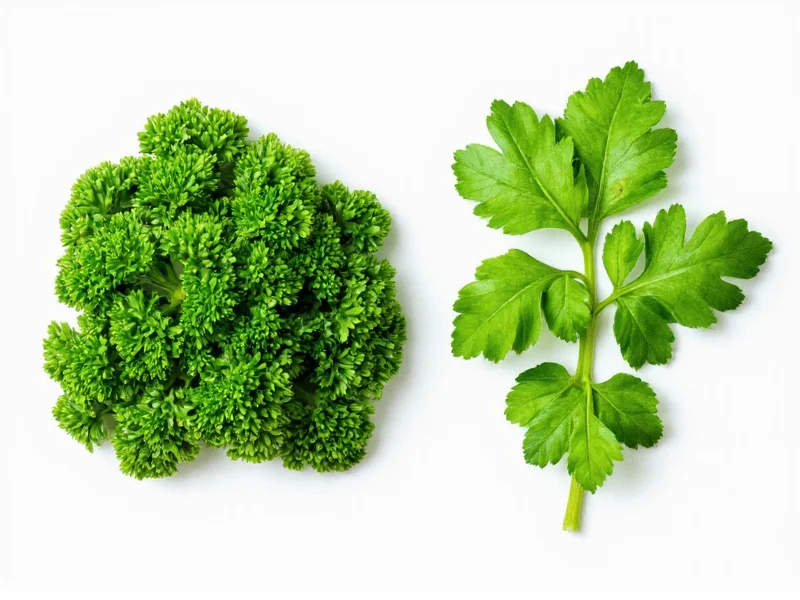Understanding the Fundamental Differences Between Parsley and Cilantro
When examining are parsley and cilantro the same, the immediate answer is clear: these are two completely separate herbs with unique botanical classifications. Parsley (Petroselinum crispum) belongs to the Apiaceae family, while cilantro (Coriandrum sativum) is part of the same family but represents the leafy stage of the coriander plant. This fundamental botanical distinction explains why these herbs look similar to untrained eyes yet deliver dramatically different flavor experiences in cooking.
Visual Identification: How to Tell Parsley from Cilantro
One of the most common points of confusion when asking are parsley and cilantro the same stems from their superficial visual similarities. However, trained cooks can distinguish them at a glance:
| Characteristic | Parsley | Cilantro |
|---|---|---|
| Leaf Shape | Broad, flat with serrated edges (flat-leaf) or tightly curled (curly) | More rounded, lacy appearance with scalloped edges |
| Stem Color | Lighter green, sometimes with reddish tinge in curly varieties | Darker green, often with purple hues |
| Leaf Texture | Firmer, more substantial feel | Softer, more delicate texture |
| Overall Appearance | More structured, upright growth pattern | More sprawling, delicate appearance |
Flavor Profiles: Why Substituting Matters
The critical difference between these herbs lies in their flavor chemistry. When considering can I substitute cilantro for parsley in recipes, understanding these flavor profiles is essential:
- Parsley: Offers a mild, slightly bitter, grassy flavor with subtle peppery notes. Flat-leaf (Italian) parsley has a more pronounced flavor than the milder curly variety.
- Cilantro: Delivers a bright, citrusy flavor with distinctive soapy notes (for those with the OR6A2 gene variation). Its flavor is much more assertive and polarizing than parsley's.
Professional chefs emphasize that substituting one for the other dramatically alters a dish's character. Mediterranean recipes calling for parsley would become unrecognizable with cilantro, while cilantro's role in Latin American and Asian cuisines cannot be replicated with parsley.
Botanical Classification Explained
Understanding the scientific difference between parsley and cilantro requires examining their botanical relationships:
- Parsley is exclusively the leafy herb from Petroselinum crispum. The plant produces seeds (called parsley seed), but these are rarely used culinarily.
- Cilantro specifically refers to the leaves and stems of Coriandrum sativum. The same plant produces coriander seeds, which have a completely different flavor profile and culinary use.
This distinction explains why some regions call the leaves "coriander" while others use "cilantro"—it's the same plant at different stages, unlike parsley which maintains its name throughout its growth cycle.
Culinary Applications and Regional Preferences
The question why do recipes specify parsley or cilantro specifically relates to regional culinary traditions:
- Parsley features prominently in European cuisines, particularly in French fines herbes, Italian gremolata, and Middle Eastern tabbouleh. Its mild flavor makes it ideal as a garnish that doesn't overpower dishes.
- Cilantro is essential in Latin American salsas, Asian curries, and Indian chutneys. Its bold flavor stands up to strong spices and acidic ingredients.
Attempting to substitute one for the other in traditional recipes creates what food historians call "culinary dissonance"—a dish that feels fundamentally "off" to those familiar with the authentic preparation.
Nutritional Comparison
While both herbs offer health benefits, their nutritional profiles differ significantly when examining is there a nutritional difference between parsley and cilantro:
- Parsley contains exceptionally high levels of vitamin K (over 1000% of daily value per 100g), substantial vitamin C, and notable iron content.
- Cilantro provides good amounts of vitamin A and vitamin K, with higher concentrations of certain antioxidants like quercetin.
Both contribute valuable phytonutrients to the diet, but neither should be consumed in large quantities as a primary nutrition source due to their typical use as flavoring agents rather than staple foods.
Growing Characteristics for Home Gardeners
For those wondering can I grow parsley and cilantro together in my garden, understanding their growing requirements is crucial:
- Parsley is a biennial plant that prefers cooler temperatures, partial shade, and consistent moisture. It grows more slowly but has a longer harvest window.
- Cilantro is an annual that bolts quickly in warm weather, preferring full sun and well-drained soil. It grows rapidly but has a shorter productive period before flowering.
Gardeners often plant cilantro successionally every few weeks to maintain a continuous harvest, while parsley provides more consistent yields throughout the growing season.
Common Misconceptions Clarified
Several myths persist around are parsley and cilantro related that deserve clarification:
- Myth: Cilantro is just Mexican parsley.
Fact: They're botanically unrelated despite similar appearances. - Myth: The soapy taste of cilantro comes from contamination.
Fact: This is genetic (OR6A2 gene variation) affecting 4-21% of populations. - Myth: Drying makes them interchangeable.
Fact: Both lose distinctive flavors when dried; neither adequately substitutes for the other.
Practical Substitution Guidance
When facing the question what can I use if I don't have cilantro or parsley, consider these professional recommendations:
- For parsley: Fresh chervil or celery leaves provide the closest flavor match without overpowering dishes.
- For cilantro: A combination of fresh basil and a squeeze of lime comes closest to replicating its unique profile.
- Never substitute dried versions of either herb for fresh in recipes specifically calling for fresh—the flavor transformation is too significant.
Understanding these distinctions helps home cooks and professional chefs alike navigate the common confusion around are flat leaf parsley and cilantro the same or whether these herbs can be used interchangeably.











 浙公网安备
33010002000092号
浙公网安备
33010002000092号 浙B2-20120091-4
浙B2-20120091-4